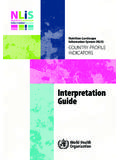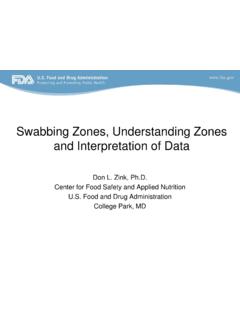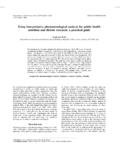Transcription of FAO FERTILIZER AND PLANT NUTRITION BULLETIN 16
1 9789251054901TC/M/A0443E/1 92-5-105490-8 ISSN 0259-2495 ISSN 0259-2495 FAOFERTILIZERAND PLANTNUTRITIONBULLETIN16 PLANT NUTRITION for food security A guide for integrated nutrient managementFOOD AND AGRICULTURE ORGANIZATION OF THE UNITED NATIONSRome, 2006 FAOFERTILIZERAND PLANTNUTRITIONBULLETIN16by RoyLand and Water Development DivisionFAO, Rome, ItalyA. FinckUniversity of KielKiel, BlairUniversity of New EnglandArmidale, TandonFertiliser Development and Consultation OrganisationNew Delhi, IndiaThe designations employed and the presentation of material in this information product do not imply the expression of any opinion whatsoever on the part of the Food and Agriculture Organization of the United Nations concerning the legal or delopment status of any country, territory, city or area or of its authorities, or concerning the delimitation of its frontiers or 92-5-105490-8 All rights reserved.
2 Reproduction and dissemination of material in this information product for educational or other non-commercial purposes are authorized without any prior written permission from the copyright holders provided the source is fullyacknowledged. Reproduction of material in this information product for resale or other commercial purposes is prohibited without written permission of the copyright holders. Applications for such permission should be addressed to: Chief Publishing Management ServiceInformation Division FAO Viale delle Terme di Caracalla, 00100 Rome, Italy or by e-mail to: FAO 2006iiiContentsPreface ixAcknowledgements xList of abbreviations and acronyms xi1.
3 Introduction 1 Present and future demands for PLANT nutrients in developing regions 22. Food security and agricultural production 5 Striving for food security 5 Food security for a growing world population 7 Food production prospects in developing countries 11 Problems and possibilities 14 Demands on agriculture for providing food security 17 Nutrients in production and consumption cycles and nutrient transfers 193.
4 PLANT nutrients and basics of PLANT NUTRITION 25 PLANT nutrients 25 Nutrients their functions, mobility in plants and deficiency/toxicity symptoms 27 Basics of PLANT NUTRITION 34 Root growth and nutrient uptake 40 Efficient use of nutrients 424. Soil fertility and crop production 43 Soils as a basis for crop production 43 Soil constituents 45 Soil properties and PLANT requirements 49 Nutrients in soils and uptake by plants 60 Dynamics of PLANT nutrients in soils 65 Dynamics of major nutrients 66 Assessment of available nutrient status of soils and plants 74 Impact of
5 Soil fertility on crop productivity 83 Fertility management of soils in different climate regions 85iv5. Sources of PLANT nutrients and soil amendments 91 Mineral sources of nutrients ( fertilizers ) 92 Organic sources of nutrients 119 Biofertilizers (microbial inoculants) 130 Soil amendments 1366. Optimizing PLANT NUTRITION 141 General aspects 141 Basic information for optimizing crop NUTRITION 148 Strategies for optimizing nutrient management 164 Integrated nutrient water management for optimizing PLANT NUTRITION 167 PLANT NUTRITION and resistance to stress 174 Nutrient management in different cropping systems 177 Optimizing nutrient management in dryland and irrigated farming
6 1867. Guidelines for the management of PLANT nutrients and their sources 193 Preconditions for successful nutrient management 193 Guidelines for nutrient management through fertilizers 196 Guidelines for FERTILIZER application 208 Guidelines for the application of organic manures 223 Guidelines for the application of biofertilizers 226 Application of soil amendments 2328. Nutrient management guidelines for some major field crops 235 Cereals and millets 235 Grain legumes 243 Oil crops 244 Root and tuber crops 251 Sugar crops 255 Fibre crops
7 258 Pastures 2609. Economic and policy issues of PLANT NUTRITION 263 Factors affecting decision making 263 Economics of FERTILIZER application 269v Economics of organic manures and biofertilizers 273 Policies for effective PLANT NUTRITION 27410. PLANT NUTRITION , food quality and consumer health 281 General aspects 281 PLANT NUTRITION and product quality 285 Consumer health issues and food quality 29211.
8 PLANT NUTRITION and environmental issues 299 Basic effects of nutrient management on the environment 299 Environmental aspects of PLANT nutrients 302 Minimizing the negative environmental effect of nutrient use 310 Glossary 315 Bibliography 339 Units and conversion factors 347viList of figures1. The effect of FERTILIZER on wheat grain yields in the Broadbalk Experiment, Rothamsted Experimental Station, the United Kingdom 12.
9 Mineral FERTILIZER consumption in terms of N + P2O5 + K2O on arable land, by region 23. Population of developing regions and cereal yields 74. Estimated global trends in population, cereal yields and source of PLANT nutrients 85. Relationship between human population and average cereal yields in six regions 96. World population, arable area and cereal yields from 1800 to 1999 127. Yield gap at various levels in relation to production factors 138. PLANT nutrients in production and consumption cycles 209. Demonstration of the law of the minimum using a barrels with staves of different heights 3510. Example of yield-limiting minimum factors 3611. PLANT growth and yield dependence on nutrient supply 3812. Uptake of nutrients from the soil by a root hair, using Ca as an example 4013. A vertical cross-section of a typical soil profile showing soil horizons 4414.
10 The World Soil Map 4515. The average proportion of various constituents in a common soil on volume basis 4716. USDA classification of soil texture classes according to proportions of sand, silt and clay 5017. Soil pH and nutrient availability 5718. Optimal soil pH for different crops 5819. Fractions of major nutrients in the soil 6320. The nitrogen cycle 6621. Phosphate dynamics in the soil 6722. Schematic representation of the three important soil P fractions for PLANT NUTRITION 6823. Potassium dynamics in the soil 6924. The sulphur cycle 7125. Representative soil sampling for small and large fields 7526. Guide for FERTILIZER compatibility and mixing 11827. Effects of liming on soil properties 13728. Yield response to balanced PLANT NUTRITION 14329. Inputs and outputs of a PLANT nutrient balance sheet with N as an example 147vii30.















